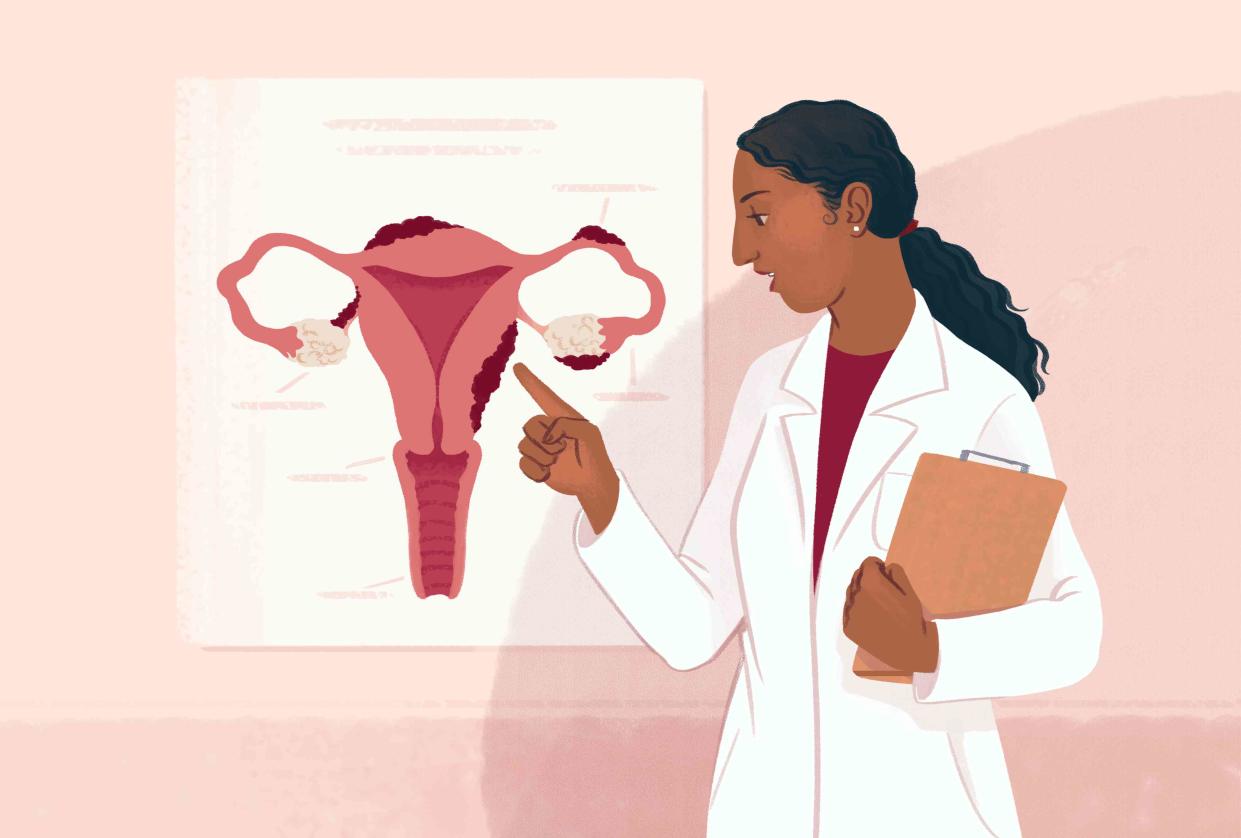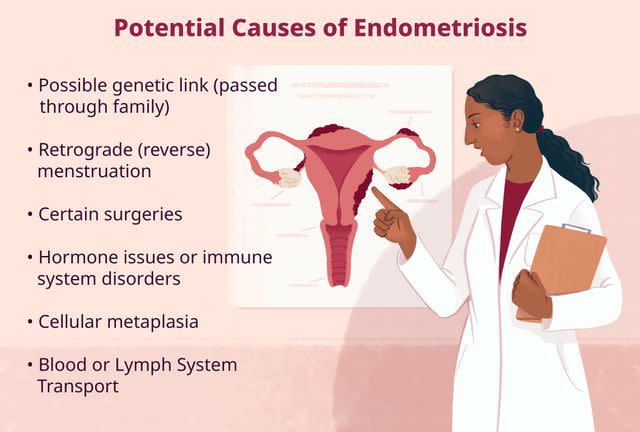Theories About Endometriosis Causes

Illustration by Mira Norian for Verywell Health
Medically reviewed by Cordelia Nwankwo, MD
Endometriosis occurs when tissue similar to the tissue that lines the uterus is present in an area outside of the uterus, such as on or in organs in the pelvis or abdomen. Experts are not sure what causes endometriosis. Several theories exist, but no one theory provides a complete explanation.
This article will discuss the theories about what causes endometriosis to develop, why symptoms arise, who is most affected by endometriosis, and ways to cope with the chronic condition.

Illustration by Mira Norian for Verywell Health
Understanding Endometriosis Causes
The exact cause of endometriosis isn't known, but several theories have been proposed. Some researchers believe there are multiple causes that interact or overlap to cause endometriosis to develop.
Genetics
While there is no evidence that endometriosis is directly inherited, it tends to run in families, indicating a possible genetic link.
Having a close relative (parent, child, or sibling) with endometriosis is a risk factor for developing the condition.
Menstruation
Retrograde menstruation (sometimes called reverse menstruation) is when some of the menstrual blood and tissue shed by the uterus during menstruation flows into the fallopian tubes. It can also flow through the fallopian tubes and into other areas of the body, like the pelvis.
Researchers believe this is a common occurrence in people who menstruate but doesn't explain why endometrial cells grow outside the uterus in some people but not others. It is likely that other factors play a role along with retrograde menstruation.
Menstruation can also cause a worsening of existing symptoms of endometriosis. The hormones that trigger endometrial tissues inside the uterus to grow and then shed also affect endometriosis tissues. Because there is nowhere for this tissue to shed, it can build up outside the uterus.
Immune System
Many people with endometriosis appear to have other immune system disorders and reduced immunity to other conditions. It hasn't been established whether this is a factor in the development of endometriosis or whether it results from having endometriosis.
One theory is that problems with the immune system impair its ability to find and destroy endometrial tissue growing in areas it shouldn't be.
Blood or Lymph System Transport
This theory suggests that endometrial tissue can use the blood or lymphatic systems to travel to other areas of the body. This is a similar mechanism to how cancer cells can spread.
Direct Transplantation
Direct transplantation involves endometrial cells being accidentally picked up and moved during surgeries such as cesarean sections (C-sections) to deliver a baby or hysterectomies to remove a uterus.
These transplanted endometrial cells may then attach to other areas of the body, like the walls of the abdomen.
Transformation
Through a process called cellular metaplasia, cells outside the uterus could become cells that are similar to endometrial cells and start growing.
Hormones
The hormone estrogen seems to contribute to the inflammation, tissue growth, and pain associated with endometriosis. The relationship is not yet fully understood as endometriosis can still occur without the influence of estrogen.
Researchers are exploring a possible link between endometriosis and a problem with the hormone system.
Who Is Most Affected by Endometriosis?
Endometriosis can happen to anyone born with a uterus, but some factors may increase the risk of developing it, including:
Having a close family member (such as a parent, child, or sibling) who has endometriosis
Being in your 30s or 40s
Having an abnormal uterus (as diagnosed by a healthcare provider)
Having a health problem that interferes with normal menstrual flow
Having your first period before age 11
Having menstrual cycles that are 27 days or shorter
Having menstrual periods that are heavy and last more than seven days
Never having given birth
Although extremely rare endometriosis can occur in people assigned male at birth.
On average, a person experiencing symptoms of endometriosis in the United States will go 10 years before receiving a proper diagnosis of endometriosis.
The variability in symptoms, limited awareness about the condition both in and out of the medical profession, and the tendency for symptoms to be attributed to something else (such as menstrual cramps) can contribute to this delay in diagnosis.
What Causes Endometriosis Symptoms?
Endometrial tissue typically grows on or around the following:
Fallopian tubes
Ovaries
Outside surface of the uterus
Uterosacral ligaments (ligaments around the uterus)
Space between the uterus and the rectum or bladder
Lining of the pelvic cavity
Less commonly, it can occur on and around the following:
This tissue can grow, swell, and bleed each month in response to menstrual cycle hormones (just as the uterine lining does). But because it is not easily expelled from the body like menstruation, it can build up, leading to inflammation and other problems.
Constipation
When endometrial tissue grows on or near the bowels, it can cause inflammation (swelling), contributing to problems such as:
Constipation
Diarrhea
Difficult or painful defecating (pooping)
Blood in the stool
Infertility
Endometriosis can affect fertility. This doesn't mean someone with endometriosis will be unable to get pregnant, but it may cause difficulties conceiving.
Exactly how endometriosis causes problems with fertility isn't known, but some possible reasons include:
Changes to the anatomy or shape of the pelvis and reproductive organs can occur, making it more difficult for sperm to reach an egg.
Scar tissue may affect the release of eggs or block the fallopian tubes.
The immune system may attack the embryo.
Sperm or fertilized eggs may become damaged before implantation.
The lining of the uterus may not develop the way it should.
Endometriomas
Endometriomas are menstrual blood–filled cysts that grow inside the ovary when blood becomes trapped from endometriosis growth. They are sometimes called chocolate cysts because of their dark brown color.
Adhesions
A "sticky" type of fibrous endometrial tissue can form, causing organs to join or bind together. This is called an adhesion, and it can cause pelvic pain.
Endometriosis can overlap with other chronic pain syndromes, causing additional pain symptoms. These can include:
Irritable bowel syndrome: A group of symptoms, such as cramping, bloating, and diarrhea, that affect the digestive system
Interstitial cystitis (painful bladder syndrome): Chronic pressure, pain, or discomfort in the bladder area
Vulvodynia: Chronic, unexplained pain in the vulva
Does Stress Cause Endometriosis?
Stress appears to be linked to endometriosis, but their exact relationship isn't fully understood. One theory is that stress causes immune system dysfunction as brought on by the buildup of the hormone cortisol, which is produced when the body is stressed.
Another link may be related to inflammation, which is increased by stress and causes pain with endometriosis.
Cause of Endometriosis Later in Life
Symptoms of endometriosis often subside after menopause, but it is estimated that the incidence of postmenopausal endometriosis is about 2% to 5%.
Most people with endometriosis after menopause had the condition when they were still menstruating, but rarely it arises in someone with no history of endometriosis before menopause.
This usually is associated with taking menopausal hormone therapy (MHT). It rarely occurs in people who have never taken MHT or the medication tamoxifen.
You Did Not Cause Your Endometriosis
People with endometriosis often feel like they are responsible for their symptoms because of something they did or did not do.
For example, a 2022 analysis of four focus group discussions found that the participants with endometriosis had been given contradictory information about following an unrealistically strict diet for managing endometriosis. When the diet became impossible to follow, many participants blamed themselves. Eventually, they found listening to their bodies and creating their own personal food practices was more manageable.
There is no known way to prevent endometriosis from developing. It does not develop from making "poor" decisions and did not result from anything you did or did not do.
Can Endometriosis Go Away?
There's no cure for endometriosis, but treatments can help relieve symptoms such as pain and can improve fertility.
Symptoms often go away after menopause because endometriosis growths can shrink with lowered estrogen levels.
If left untreated, endometriosis might improve on its own, but it can also get worse. If symptoms are tolerable, watching symptoms for changes before beginning treatment is an option.
What Is the Latest Research on Endometriosis?
Research is looking into the possibility of endometriosis being an autoimmune disease. Some studies suggest that it may be caused by a combination of retrograde menstruation and an immune response.
To date, there is still no fully supported or understood theory for what causes endometriosis.
Tips to Cope With Endometriosis
Nonsteroidal anti-inflammatory drugs (NSAIDs), including Advil or Motrin (ibuprofen), may be helpful for pain management. For more severe pain, prescription medications may be recommended by your healthcare provider.
Symptoms may also be eased with at-home remedies such as:
Taking a warm bath
Resting
Practicing relaxation and meditation exercises
Taking steps to prevent constipation
Getting regular exercise
Applying a hot water bottle or heating pad to your abdomen
Support from partners, friends, family, community, and online groups can also be very helpful for people with endometriosis.
If you have been diagnosed with endometriosis and want to identify what may trigger an endo flare, keep a journal of possible triggers such as your menstrual cycle, stress, sleep quality, constipation, exercise, intake of alcohol and caffeine, and diet.
Summary
The cause of endometriosis isn't known, but some theories include genetics, retrograde menstruation, immune system involvement, blood and lymph system transportation, direct transplantation, transformation, and hormones. Multiple factors at one time may be involved.
Endometriosis can cause inflammation leading to problems with surrounding organs, such as constipation. Endometriosis can lead to blood-filled ovarian cysts, scar tissue, and adhesions. Problems with fertility can also occur with endometriosis.
Endometriosis is currently being researched as a possible autoimmune disease.

